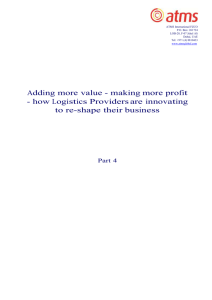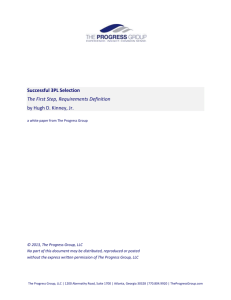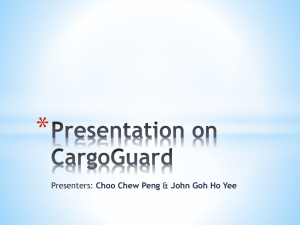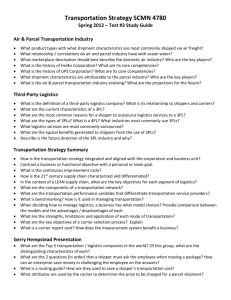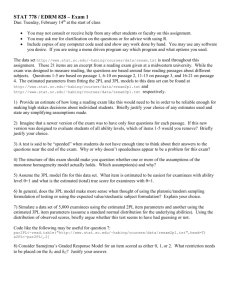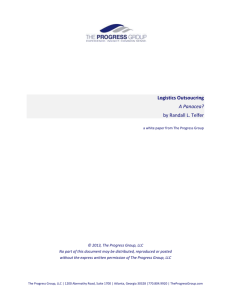Draft Presentation
advertisement
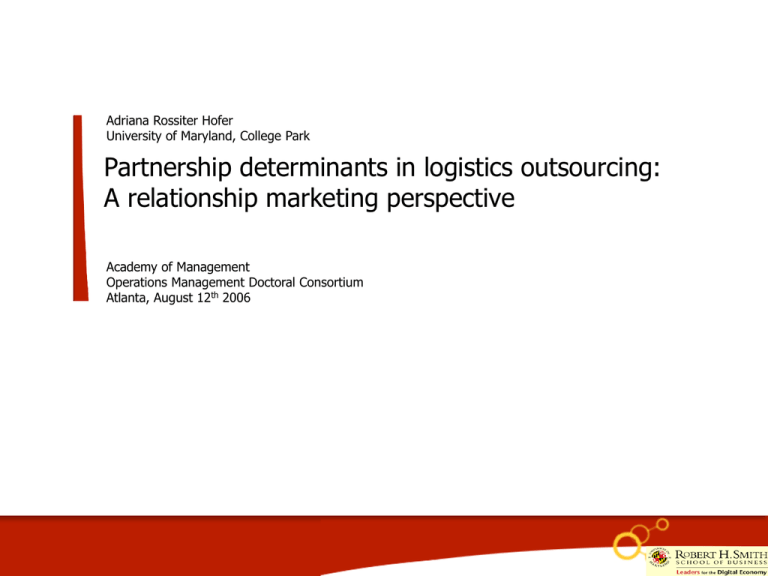
Adriana Rossiter Hofer University of Maryland, College Park Partnership determinants in logistics outsourcing: A relationship marketing perspective Academy of Management Operations Management Doctoral Consortium Atlanta, August 12th 2006 About my dissertation – Dissertation Committee: • • • • • Prof. Prof. Prof. Prof. Prof. Martin E. Dresner, Chair (Logistics and Transportation) A. Michael Knemeyer (Supply Chain Management) Curtis M. Grimm (Supply Chain Management and Strategy) William J. DeWitt (Logistics and Transportation) Donna B. Hamilton, Dean’s representative (English) – Defended proposal in May, pretest in process About my dissertation – Research questions: • What factors impact firm partnering behavior with third-party logistics providers (3PLs)? • What is the interplay between firm, inter-organizational, and environmental factors? – Expected contributions: • Academic: – Theory-based model of partnering in logistics outsourcing relationships – Integration of partnering and marketing literatures, applying them in a different context • Practical: – Assist 3PLs by enhancing their relationships with customers, thus retaining and expanding customer base – Research methodology: cross-sectional survey, structural equation modeling – Unit of analysis: relationship, 3PL customer is the focal firm Building closer relationships is growing in importance for 3PLs and customer firms On the customer side: On the 3PL side: - - Globalization Competition Complex supply chains Increasing customer demands Increasing customer demands Increasing competition Higher fuel prices, driver shortages Capacity crunch Need to work together! Showing that they are reliable partners is a strong feature of 3PLs’ marketing strategy Theory-based 3PL research has focused on the positive effects of close logistics outsourcing relationships … – Relationship characteristics (e.g., communication, reputation) positively influence performance and relationship outcomes (e.g., customer retention, referrals, service recovery) (Knemeyer and Murphy 2004, 2005) – Relationship orientation improves supply chain effectiveness and performance (Panayides and So 2005) – Positive effect of relational performance on customer market share (Stank et al 2003) … and this research aims to look at the antecedents of these relationships. The model builds upon Ganesan (1994): “Determinants of long-term orientation in buyer-seller relationships” Theoretical framework: relationship marketing + social exchange theory (SET) Structure of the model 3 2 1 ANTECEDENT PRIMARY ANTECEDENT ANTECEDENT DEPENDENT VARIABLE ANTECEDENT PRIMARY ANTECEDENT ANTECEDENT Defining the dependent variable: degree of partnering … “A partnership is a tailored business relationship based on mutual trust, openness, shared risk and shared rewards that result in business performance greater than would be achieved by the two firms working together in the absence of partnership.” (Lambert et al 2004) • Partnership behavioral elements are drawn from relational contract literature • • • • • (Gardner et al 1994): planning sharing benefits and burdens extendedness systematic operational information exchange mutual operating controls No partnership elements present Many elements of partnership present Just short of full vertical integration, e.g., corporate vertical marketing systems Arm’s length Range of relationship styles (Source: Gardner et al 1994) SET suggests that relationship formation and development are based on interorganizational factors Lambe et al 2001 A firm engages in a relationship because it believes it will be rewarding Interactions > CL ? Outcomes are compared to two standards (Comparison Levels - CL): Trust is built over time… > CLalt ? satisfaction dependence Earlier partnering experiences with other 3PLs might affect the firm’s capability to engage in such relationships… - From a social network perspective, prior experiences with other partners - Shape firm’s expectations regarding the new relationships - Increase the likelihood of future endeavors (Uzzi 1996): - Previous positive experiences with other 3PLs should impact a firm’s comparison level: - Learning effect - More realistic expectations Hypothesis: Prior experience with partnering with 3PLs is positively associated with the degree of partnering with the focal 3PL. Relationship marketing research has emphasized that some firms employ relationship marketing as a philosophy: Relationship Marketing Orientation - To use relationship marketing, a relationship orientation must pervade the mindset, values and norms of the organization (Day 2000) - Relationship Marketing Orientation: “an organizational culture that puts the buyer-seller relationship at the center of the firm strategic or operational thinking” (Tse et al 2004, Sin et al 2005) - Carriers within buyer-seller partnerships exhibit higher degrees of partnership elements (Gentry 1996) - Trust and commitment are mediators of satisfaction only for high relational customers (Garbarino and Johnson 1999) 3PL 3PL customer relationship buyer Hypothesis: A 3PL customer’s relationship marketing orientation is positively associated to the degree of partnering with a 3PL A model of 3PL customer’s degree of partnering 7 Primary Hypotheses Dependence of customer on 3PL Sub-model 1 Perception of 3PL’s dependence on customer 3PL’s credibility (trust) Sub-model 2 3PL’s benevolence (trust) Degree of partnering Prior experience partnering Relationship Marketing Orientation Satisfaction with previous outcomes *Based on and expanded from Ganesan (1994) The antecedents of dependence are related to environmental, relationship, and firm specific factors Antecedents of Dependence (Sub-model 1) Customer capabilities Env. Diversity 3PL market Env. Volatility 3PL market Env. Diversity Product market Env. Volatility Product market Logistics complexity TSI by customer Perception of TSI by 3PL Dependence of customer on 3PL Perception of 3PL’s dependence on customer Environmental uncertainty in the market for 3PL services: Diversity negatively related to customer’s dependence on 3PL Volatility positively related to customer’s dependence on 3PL Environmental uncertainty in the product market: Diversity positively associated with customer’s dependence on 3PL Volatility positively associated with customer’s dependence on 3PL Transaction-specific investments: TSI by customer positively related to dependence on 3PL and negatively related to perceived 3PL dependence Perception of 3PL TSI negatively related to customer’s dependence and positively related to perceived 3PL dependence Firm specific: Complexity of logistics operations positively associated with customer’s dependence on 3PL Customer’s logistics capabilities negatively associated with customer’s dependence on 3PL The antecedents of trust are mainly related to the partner’s behavior and experience with the partner Antecedents of Trust (Sub-model 2) • A 3PL customer’s perception of the 3PL’s TSI is positively related to the customer’s perception of the 3PL credibility and benevolence. Perception of TSI by 3PL Reputation of the 3PL 3PL’s credibility (trust) Customer’s experience with 3PL 3PL’s benevolence (trust) Satisfaction with previous outcomes • The reputation of a 3PL is positively related to its customer’s perception of the 3PL’s credibility. • A customer’s experience with a 3PL is positively related to the customer’s perception of the 3PL’s credibility. • A 3PL customer’s satisfaction with past outcomes is positively related to the customer’s perception of the 3PL’s credibility and benevolence. Final Model Customer capabilities Env. diversity 3PL market Env .volatility 3PL market Env. diversity product market Env. volatility product market Dependence of customer on 3PL Perception of 3PL’s dependence on customer Degree of partnering Logistics complexity TSI by customer Perception of TSI by 3PL Reputation of the 3PL Customer’s experience with 3PL Satisfaction with previous outcomes 3PL’s credibility (trust) 3PL’s benevolence (trust) Prior experience 3PL partnering Relationship Marketing Orientation *Based on and expanded from Ganesan (1994) Research Methodology - Web-based survey of customers of Rapidão Cometa, a large Brazilian 3PL - Large array of services offered - Diverse customer base: various industries, sizes, logistics functions contracted, experience - Diversity of relationship styles Survey design and implementation Research Methodology - Measurement of the constructs: - most items adapted from existing research - logistics complexity and capabilities: new scales - Survey pretests: concurrent and retrospective think-aloud interviews - Survey implementation: - Sample size: approximately 4,000 customer firms - Key informants: provided by Rapidão Cometa - Pre-notification e-mail (Rapidão Cometa) - Web-based survey implementation - Thank you/reminder e-mails - Test for non-response bias Structural Equation Modeling Research Methodology - Quality of data evaluation: - Check for outliers - Check for symmetry - Check for missing data - Controls (as in Knemeyer and Murphy 2005): firm size and number of functions outsourced - Tests for unidimensionality, convergent and discriminant validity, and scale reliability - Two-step SEM with EQS software: - Measurement phase - Structural phase - Check goodness-of-fit information - Interpretation of path coefficients Concluding Remarks - Managerial implications: - What factors should 3PLs emphasize in their relationship with customers and in the pursuit of new customers - Relative impact firm vs. environmental vs. relationship characteristics on partnering behavior - Limitations: - Not capturing dyadic observations - All firms are customers of a single 3PL - asset based firm Thank you! Questions? Comments? Extras … Partnership Construct (Gardner et al 1994) Partnership behavior ….. Extendedness Operational Info Exchange Operating Controls Sharing Benefits & Burdens Planning Partnership Construct: a second order factor? Partnership behavior Extendedness Operational Info Exchange Operating Controls Sharing Benefits & Burdens Planning Primary Hypotheses: H1: Dependence of a customer on a 3PL is positively related to the customer’s degree of partnering. H2: Perceived dependence of a 3PL on a customer is negatively related to the customer’s degree of partnering. H3: A customer’s trust in a 3PL’s credibility is positively related to the degree of partnering. H4: A customer’s trust in a 3PL’s benevolence is positively related to the degree of partnering. H5: A customer’s satisfaction with past outcomes of the relationship with a 3PL is positively related to the customer’s degree of partnering with that 3PL. H6: There is a positive relationship between prior experience with partnering with 3PLs and the degree of partnering with the focal 3PL. H7: There is a positive relationship between a customer’s relationship marketing orientation and the degree of partnering with a 3PL, all else constant. Antecedents of dependence: H8: Environmental volatility in the product market is positively related to a customer’s dependence on a 3PL. H9: Environmental diversity in the product market is positively related to a customer’s dependence on a 3PL. H10: Environmental volatility in the market for 3PL services is positively related to a customer’s dependence on a 3PL. H11: Environmental diversity in the market for 3PL services is negatively related to a customer’s dependence on a 3PL. H12: A customer’s logistics complexity is positively related to a customer’s dependence on a 3PL.\ H13: A customer’s TSIs are positively related to a customer’s dependence on a 3PL. H14: A customer’s TSIs are negatively related to a customer’s perception of 3PL dependence on a customer. H15: A customer’s perception of a 3PL’s TSIs is negatively related to a customer’s dependence on a 3PL. H16: A customer’s perception of a 3PL’s TSIs is positively related to a customer’s perception of a 3PL dependence. H17: There is a negative relationship between customer’s perceived logistics capabilities and dependence on a 3PL. Antecedents of trust: H18: The reputation of a 3PL is positively related to its customer’s perception of the 3PL’s credibility. H19: A customer’s satisfaction with past outcomes is positively related to the customer’s perception of the 3PL’s credibility. H20: A customer’s satisfaction with past outcomes is positively related to the customer’s perception of the 3PL’s benevolence. H21: A customer’s experience with a 3PL is positively related to the customer’s perception of the 3PL’s credibility. H22: A customer’s experience with a 3PL is positively related to the customer’s perception of the 3PL’s benevolence. H23. A customer’s perception of 3PL specific investments is positively related to the customer’s perception of the 3PL’s credibility. H24. A customer’s perception of 3PL specific investments is positively related to the customer’s perception of the 3PL’s benevolence.
